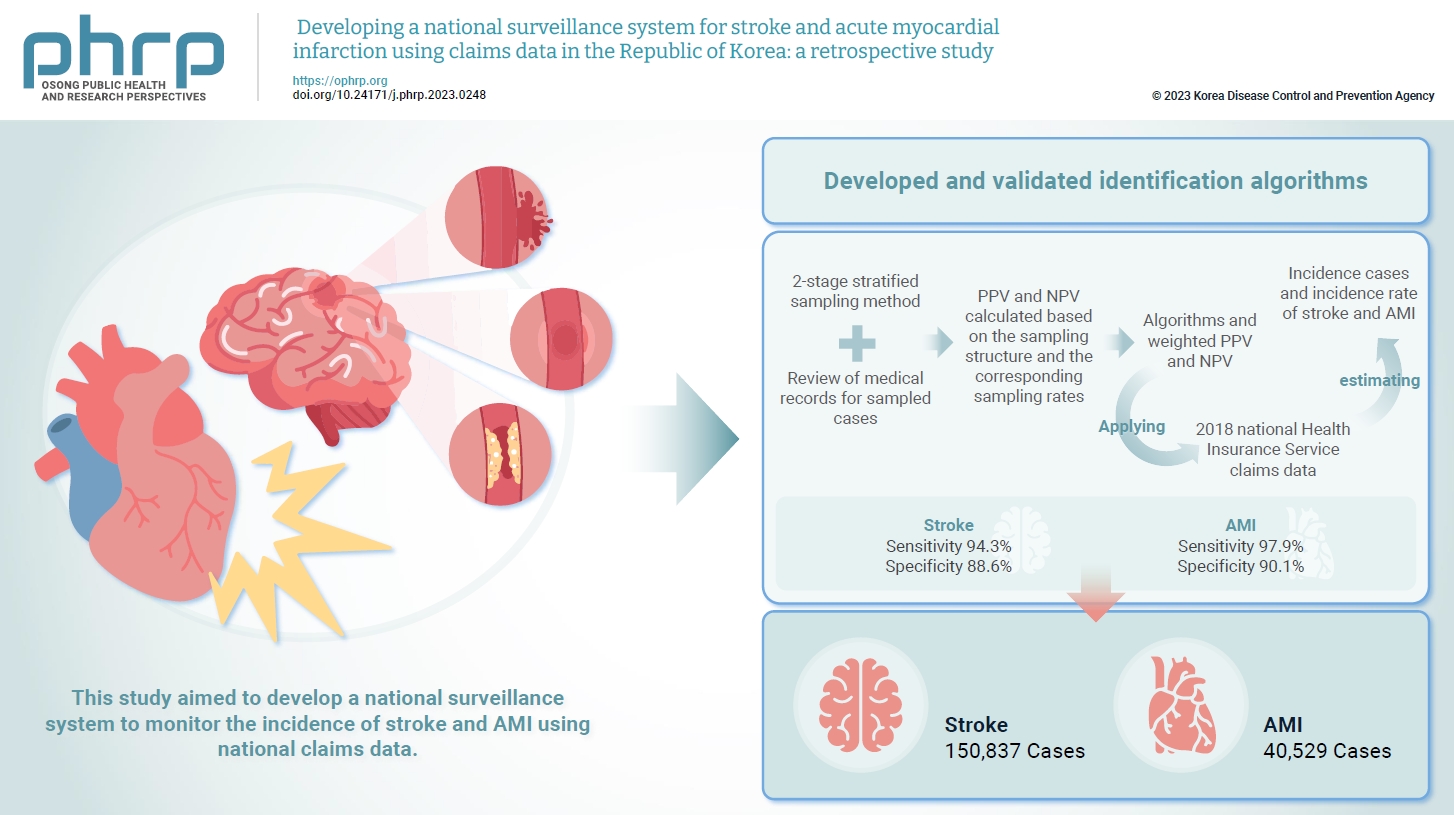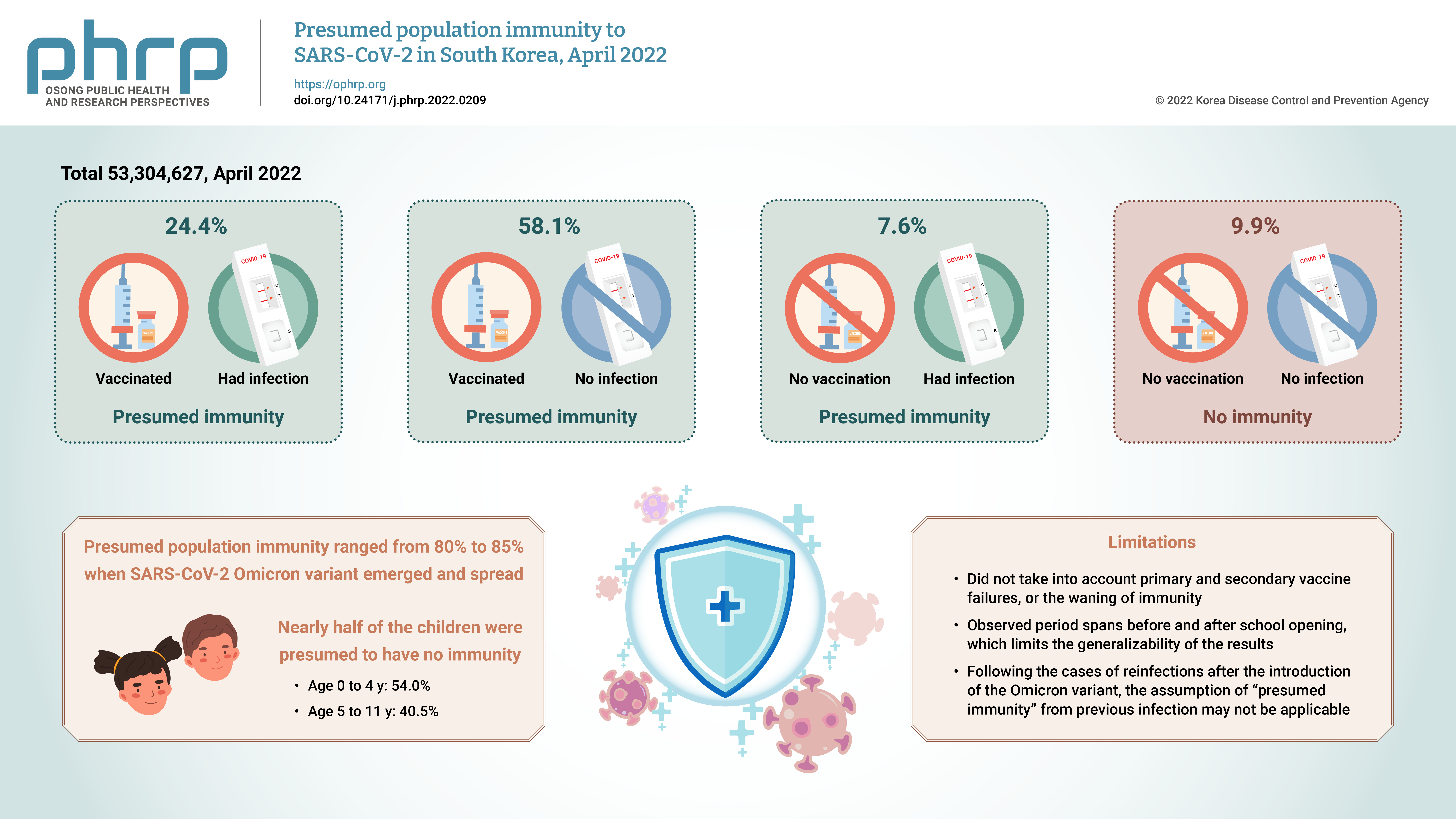Search
- Page Path
- HOME > Search
Original Article
- Developing a national surveillance system for stroke and acute myocardial infarction using claims data in the Republic of Korea: a retrospective study
- Tae Jung Kim, Hak Seung Lee, Seong-Eun Kim, Jinju Park, Jun Yup Kim, Jiyoon Lee, Ji Eun Song, Jin-Hyuk Hong, Joongyub Lee, Joong-Hwa Chung, Hyeon Chang Kim, Dong-Ho Shin, Hae-Young Lee, Bum Joon Kim, Woo-Keun Seo, Jong-Moo Park, Soo Joo Lee, Keun-Hwa Jung, Sun U. Kwon, Yun-Chul Hong, Hyo-Soo Kim, Hyun-Jae Kang, Juneyoung Lee, Hee-Joon Bae
- Osong Public Health Res Perspect. 2024;15(1):18-32. Published online January 31, 2024
- DOI: https://doi.org/10.24171/j.phrp.2023.0248
- 921 View
- 58 Download
-
 Graphical Abstract
Graphical Abstract
 Abstract
Abstract
 PDF
PDF 
- Objectives
Limited information is available concerning the epidemiology of stroke and acute myocardial infarction (AMI) in the Republic of Korea. This study aimed to develop a national surveillance system to monitor the incidence of stroke and AMI using national claims data. Methods: We developed and validated identification algorithms for stroke and AMI using claims data. This validation involved a 2-stage stratified sampling method with a review of medical records for sampled cases. The weighted positive predictive value (PPV) and negative predictive value (NPV) were calculated based on the sampling structure and the corresponding sampling rates. Incident cases and the incidence rates of stroke and AMI in the Republic of Korea were estimated by applying the algorithms and weighted PPV and NPV to the 2018 National Health Insurance Service claims data. Results: In total, 2,200 cases (1,086 stroke cases and 1,114 AMI cases) were sampled from the 2018 claims database. The sensitivity and specificity of the algorithms were 94.3% and 88.6% for stroke and 97.9% and 90.1% for AMI, respectively. The estimated number of cases, including recurrent events, was 150,837 for stroke and 40,529 for AMI in 2018. The age- and sex-standardized incidence rate for stroke and AMI was 180.2 and 46.1 cases per 100,000 person-years, respectively, in 2018. Conclusion: This study demonstrates the feasibility of developing a national surveillance system based on claims data and identification algorithms for stroke and AMI to monitor their incidence rates.
Brief Report
- Presumed population immunity to SARS-CoV-2 in South Korea, April 2022
- Eun Jung Jang, Young June Choe, Seung Ah Choe, Yoo-Yeon Kim, Ryu Kyung Kim, Jia Kim, Do Sang Lim, Ju Hee Lee, Seonju Yi, Sangwon Lee, Young-Joon Park
- Osong Public Health Res Perspect. 2022;13(5):377-381. Published online October 14, 2022
- DOI: https://doi.org/10.24171/j.phrp.2022.0209
- 2,348 View
- 71 Download
- 3 Web of Science
- 4 Crossref
-
 Graphical Abstract
Graphical Abstract
 Abstract
Abstract
 PDF
PDF 
- Objectives
We estimated the overall and age-specific percentages of the Korean population with presumed immunity against severe acute respiratory syndrome coronavirus 2 (SARSCoV-2) as of April 2022 using the national registry.
Methods
We used the national coronavirus disease 2019 (COVID-19) infection and vaccination registry from South Korea, as described to define individuals with a previous history of COVID-19 infection, vaccination, or both, as persons with presumed immunity.
Results
Of a total of 53,304,627 observed persons, 24.4% had vaccination and infection, 58.1% had vaccination and no infection, 7.6% had infection and no vaccination, and 9.9% had no immunity. The SARS-CoV-2 Omicron variant emerged at a time when the presumed population immunity ranged from 80% to 85%; however, nearly half of the children were presumed to have no immunity.
Conclusion
We report a gap in population immunity, with lower presumed protection in children than in adults. The approach presented in this work can provide valuable informed tools to assist vaccine policy-making at a national level. -
Citations
Citations to this article as recorded by- Realistic Estimation of COVID-19 Infection by Seroprevalence Surveillance of SARS-CoV-2 Antibodies: An Experience From Korea Metropolitan Area From January to May 2022
In Hwa Jeong, Jong-Hun Kim, Min-Jung Kwon, Jayoung Kim, Hee Jin Huh, Byoungguk Kim, Junewoo Lee, Jeong-hyun Nam, Eun-Suk Kang
Journal of Korean Medical Science.2024;[Epub] CrossRef - Epidemiology of Coronavirus Disease 2019 in Infants and Toddlers, Seoul, South Korea
JiWoo Sim, Euncheol Son, Young June Choe
Pediatric Infection & Vaccine.2024; 31(1): 94. CrossRef - Predicting adherence to COVID-19 preventive measures among South Korean adults aged 40 to 69 Years using the expanded health empowerment model
Su-Jung Nam, Tae-Young Pak
SSM - Population Health.2023; 22: 101411. CrossRef - Acute COVID-19 in unvaccinated children without a history of previous infection during the delta and omicron periods
Jee Min Kim, Ji Yoon Han, Seung Beom Han
Postgraduate Medicine.2023; 135(7): 727. CrossRef
- Realistic Estimation of COVID-19 Infection by Seroprevalence Surveillance of SARS-CoV-2 Antibodies: An Experience From Korea Metropolitan Area From January to May 2022
Original Article
- Changes in the pattern and disease burden of acute respiratory viral infections before and during the COVID-19 pandemic
- Chungmin Park, Donghan Lee, Bryan Inho Kim, Sujin Park, Gyehee Lee, Sangwoo Tak
- Osong Public Health Res Perspect. 2022;13(3):203-211. Published online June 30, 2022
- DOI: https://doi.org/10.24171/j.phrp.2022.0144
- 4,403 View
- 168 Download
- 1 Web of Science
- 1 Crossref
-
 Abstract
Abstract
 PDF
PDF - Objectives
We conducted a comparative analysis of the differences in the incidence of 8 acute respiratory viruses and the changes in their patterns before and during the coronavirus disease 2019 (COVID-19) pandemic. Methods: Three sentinel surveillance systems of the Korea Disease Control and Prevention Agency and data from the Health Insurance Review and Assessment Service were analyzed. The average numbers of reported cases and the related hospital admissions and outpatient data were compared between April 2018–2019 and 2020–2021. Changes in the disease burden and medical expenditures between these 2 time periods were evaluated. Results: During the COVID-19 pandemic, the number of reported cases of all acute respiratory viral infections, except for human bocavirus, decreased significantly. Data from the Health Insurance Review and Assessment Service also showed decreases in the actual amount of medical service usage and a marked reduction in medical expenditures. Conclusion: Non-pharmacological interventions in response to COVID-19 showed preventive effects on the transmission of other respiratory viruses, as well as COVID-19. Although COVID-19 had a tremendous impact on society as a whole, with high social costs, there were also positive effects, such as a reduction in the incidence of acute respiratory viral infections. -
Citations
Citations to this article as recorded by- Machine learning forecasts for seasonal epidemic peaks: Lessons learnt from an atypical respiratory syncytial virus season
Roger A. Morbey, Daniel Todkill, Conall Watson, Alex J. Elliot, André Ricardo Ribas Freitas
PLOS ONE.2023; 18(9): e0291932. CrossRef
- Machine learning forecasts for seasonal epidemic peaks: Lessons learnt from an atypical respiratory syncytial virus season
Article
- Epidemiological and Immunological Characteristics at the Time of HIV Diagnosis for HIV/AIDS Cohort Registrants Representative of HIV-Infected Populations in Korea
- Jin-Hee Lee, Seung Hyun Kim, Jin-Sook Wang, Kyoung Mi Sung, Sung Soon Kim, Mee-Kyung Kee
- Osong Public Health Res Perspect. 2012;3(2):100-106. Published online June 30, 2012
- DOI: https://doi.org/10.1016/j.phrp.2012.04.002
- 2,811 View
- 22 Download
- 2 Crossref
-
 Abstract
Abstract
 PDF
PDF - Objectives
The Korea HIV/AIDS cohort was constructed with 18 hospitals that care for HIV-infected individuals in 2006. We compared the epidemiological and immunological characteristics of the cohort registrants with those of the HIVinfected population at the time of HIV diagnosis.
Methods
This study was conducted on 5717 people living with HIV/AIDS from 1985 to 2009, of which 789 individuals registered with the Korea HIV/AIDS cohort study. Individuals who had data from initial CD4+ T-cell counts measured within 6 months following HIV diagnosis were selected as study participants to predict the status of disease progression at the time of HIV diagnosis. A total of 2886 patients (50%) were selected from people living with HIV/AIDS, of whom 424 individuals (54%) were cohort registrants. The χ2 test and Wilcoxon rank sum test were used for analysis.
Results
The distributions of age, marital status, diagnosed regions, reason for HIV testing, and screening site were similar between the HIV-infected population and the cohort registrants. In 1985–2004, the male ratio for the cohort registrants (94.3%) was significantly higher than that measured for the HIV-infected population (89.5%) (p = 0.0339). With regard to transmission route, homosexual contact of cohort registrants (46.6%) was higher than that of the HIV-infected population (40.1%) (p = 0.022) in 2005–2009. No statistical difference in CD4+ T-cell counts at the time of HIV diagnosis was found between the HIVinfected population and cohort registrants (p = 0.2195).
Conclusion
The Korea HIV/AIDS cohort registrants represent the HIV-infected population, and the data collected from this cohort could be used as a foundation for national statistics. -
Citations
Citations to this article as recorded by- Changing Patterns of HIV Epidemic in 30 Years in East Asia
S. Pilar Suguimoto, Teeranee Techasrivichien, Patou Masika Musumari, Christina El-saaidi, Bhekumusa Wellington Lukhele, Masako Ono-Kihara, Masahiro Kihara
Current HIV/AIDS Reports.2014; 11(2): 134. CrossRef - Can Stigma Still Distort the Spectrum of a Disease?
Hae-Wol Cho, Chaeshin Chu
Osong Public Health and Research Perspectives.2012; 3(2): 65. CrossRef
- Changing Patterns of HIV Epidemic in 30 Years in East Asia



 First
First Prev
Prev


